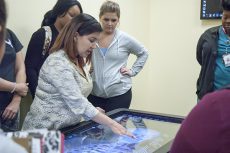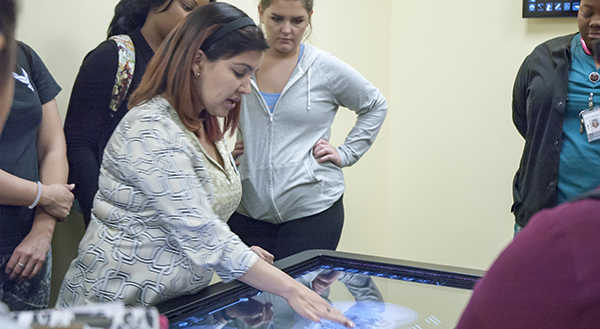By Audrey Werth/ tr news editor
TR students can now see scans from an actual cadaver to study relationships between different systems in the body.
At the end of the fall semester, the campus purchased an Anatomage Table, a virtual touch-screen medical table for its biology and anatomy and physiology students.

Audrey Werth/The Collegian
“The program allows students to look either at a male or female body or even specific people from clinical cases,” physical and life sciences learning lab manager Heidy McDonald said.
McDonald said these tables have been around for at least 10 years, but the technology has advanced significantly in that time.
“This is the latest technology, so now you are able to do a lot more with them,” she said.
The table allows users to select a scalpel to cut the body and view a cross-section. With the table, professors can also select one or several systems in the body, like muscular, nervous and cardiovascular, to see what it represents in the body and the way those systems are interrelated.
Along with the new Anatomage Table for students on TR, TREC has the same type of interactive anatomy table.
“One of the things that our Rad Tech [radiology technology] students can do is they can insert things through that [USB] drive. If they’ve been studying a specific patient, they can insert it here and work with that specific patient,” academic affairs vice president Bryan Stewart said.
This is the first full semester classes on TR have had this technology available, so they are seeing now how beneficial it is, he said.
“It’s really versatile depending on what the student is studying,” Stewart said.
McDonald said she likes to bring her classes to use the table in smaller groups so each student can interact with the table and gain a better understanding of how systems in the body relate to each other.
“Let’s say, I don’t want to see the muscles. I just want to see the internal organs,” McDonald said. “I removed all nerves and blood vessels that could get in the way, but I left the bones. This allows us to see the relationship between these systems.”
The table allows instructors to show students each layer and system within the body. The virtual cadavers can be turned and viewed from any angle.
“It’s as close to a cadaver as we’re going to get,” TR student Anna Koenig said.
Koenig said she likes reading her books, but because the images are only two-dimensional, it isn’t nearly as detailed as studying the body can be with the virtual Anatomage Table.
“I think it’s very hands-on because it’s more 3-D, and it gives you an idea of what the body would actually be like,” TR student Alyssa Lee said.

